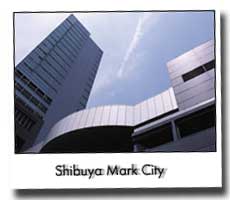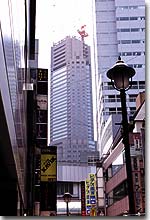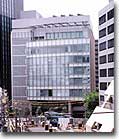Real Estate Boom 2.0
Back to Contents of Issue: July 2000
|
by Kyoko Fujimoto |
|
 Everyone knows about Japan's real estate boom during the Bubble Economy -- it's
largely responsible for the last 10 years of recession. Now there's a more seasoned
and selective boom under way -- call it Real Estate Boom 2.0. This one rewards
only the IT-compatible properties favored by the New Economy players -- the companies
that are, after all, pulling Japan out of its recession and into the future.
Everyone knows about Japan's real estate boom during the Bubble Economy -- it's
largely responsible for the last 10 years of recession. Now there's a more seasoned
and selective boom under way -- call it Real Estate Boom 2.0. This one rewards
only the IT-compatible properties favored by the New Economy players -- the companies
that are, after all, pulling Japan out of its recession and into the future.
Tech companies and Internet startups are growing at incredible rates in Japan, and that's leading to a huge demand for modern, IT-compatible buildings in the right areas. When there's a vacancy in such buildings, however, neighboring techie tenants usually expand into the space before anyone else gets a chance. Which is why such buildings never need to advertise vacancies. The competition is especially fierce in Shibuya: besides being home to many a Net startup, this "heart of Bit Valley" is short on IT-compatible office space. When Shibuya Mark City, a huge office and hotel complex, opened in Shibuya this spring, "We were flooded with inquiries -- office space filled up almost instantly," says Yuko Mikami, an assistant transaction manager at real estate agent and consulting firm Ikoma CB Richard Ellis. All of the office floors, 11 through 23, were rented out well before the opening date -- most at the beginning of the year. While the complex, originally planned to be less expensive to build at the end of the bubble era, wasn't designed with Web startups in mind, it meets all their basic IT demands. Tenants include gamemaker Konami; NTT Electronics, the software developer for NTT; online ad agency Cyber Agent; security software maker Network Associates; and SunBridge's Venture Habitat, an Internet incubator -- though it hates the word incubator (see interview with Allen Miner). "When I was looking for a place, I always asked what other companies were in the building," says Takao Ozawa, president of the recently relocated e-commerce company Bizseek. "I felt more comfortable when there were other IT-related companies inside. Of course, I checked the electrical capacity and other specifications myself, but who's in that building also told me something." What makes a building popular among Tokyo tech outfits? Electrical capacity is of course important for any company using lots of computers. Most new buildings have about 50 to 60 VA/m2 capacity, which should be enough. Older buildings with less capacity may have a hard time attracting tech companies. "I wanted at least 60, and our new office has 75VA/m2," says Bizseek's Ozawa. Another spec popular among IT companies is the "free-access floor," which means the floor has a double bottom and there is an empty space between the layers for computer cables to go under. Initially this design targeted IT departments, but as LANs were implemented everywhere, it became the standard for office buildings. The Kasumigaseki Building, the oldest skyscraper in Japan (built in 1968), and the Mitsui Building, another huge one in Shinjuku (built in 1974), have recently renovated to get a free-access floor. Other possible locations for placing cables include ceilings and walls. CNET in San Francisco, for example, rather decoratively runs cables up its walls and the along its high ceilings. In addition to computer cables, newer buildings need to have telephone and electric cables free to access from everywhere; some older buildings still have fixed lines for those cables, which makes the floor layout difficult to design. Fiber-optic networks are another popular spec among IT companies. If the area is already connected to one of these networks, there's a chance the building is, too. Mori Building, a building developer and maintenance firm, has partnered with MCI WorldCom to build fiber networks linking at least 40 Mori buildings around Tokyo. Mitsubishi Estate and NTT-ME have teamed up for the Marunouchi Super Net Project, which offers fiber connections to about 30 buildings in the Marunouchi area, not to mention additional services like online shopping for office supplies. Whether the fiber is ready or not depends on the building, says one real estate
agent. Many buildings in areas like Aoyama and Shibuya, areas that foreign-affiliated
firms often prefer, already have fiber networks. But one agent remembers an unfortunate
client having a problem installing fiber into a building located in the eastern
side of Minato-ward. The agent says that many of the more Net-savvy corporate
customers ask whether the building is fiber ready, and if so whether it's possible
to use carriers other than NTT (which many say still charges monopoly prices).
Ceiling height is also a factor when choosing office space, especially nowadays with more foreign companies (and tall gaijin) coming into Japan. The standard ceiling height for older buildings was about 2.5 meters -- - the cause of many a bruised forehead and bitten tongue. Newer buildings usually have 2.6 meters or more "valid space," excluding that taken up by layered flooring. Older buildings don't have the layered floor; once those are added, the ceiling height will decrease even more.
Earthquakes are another concern. After the '95 Kobe quake, "Many potential customers called in and asked if the buildings we were referring were OK," recalls Mikami. But buildings constructed after 1982 adhere to newer earthquake codes, and no such buildings were seriously damaged in Kobe. Location is still one of the top factors," says Tomoyuki Hiraoka at the Office Leasing Department of real estate agency Ken Corporation. "Office space is very expensive in areas like Marunouchi," says Aki Hattori, a consultant at Ikoma Data Service System, which compiles the data for the publication Office Market Report. "Buildings in the Marunouchi area are getting old, but it is still regarded as the traditional area for well-established companies. You have to pay extra for the name." According to the spring 2000 Office Market Report, the average asking rent in Marunouchi, Otemachi, and Yurakucho is ¥31,710 per tsubo (1 tsubo = 3.3 square meters), compared to more affordable areas like Shibuya, where the average is ¥17,270, or Shinjuku, where it's ¥16,190. "Only financial institutions or conglomerates are willing to pay for that," says Hattori. "And IT companies usually have more important things to worry about [than prestigious location], such as electrical capacity or duct systems, which are better in newer buildings." That may be why there are many IT companies in Shinjuku, where many of the bigger buildings are relatively new. Cisco Systems, based in Marunouchi, has recently expanded to Shinjuku. Although a company spokesperson denies a recent newspaper article saying Cisco wasn't happy with the building specifications in Marunouchi, the departments that moved to Shinjuku were information technology and customer support. There aren't many big office buildings in Shibuya. That's one of the reasons
Mark City filled up several months before it officially opened. Allen Miner of
SunBridge says he looked for other offices around Shibuya but couldn't find any
other big spaces like that. This also explains the early popularity of a building
still under construction in Shibuya -- - Cerulean Tower. Though it won't be completed
until next spring and there isn't even a model space to show yet, inquiries are
already pouring in, says Mikami. Cerulean Tower will be a combination office/hotel
building, with six floors underground and 41 floors above. The 4th to 16th floors
will be used as office space.
But Chidori believes the recently constructed buildings will do for a while. "The same type of buildings will continue to be built for the next several years or so," he says. "And the demand for such buildings is still very high."
Another question to ponder is which neighborhoods will have the most expensive real estate five years from now. Most Tokyoites would not agree that Bit Valley areas like Shibuya or Shinjuku could ever overtake more established commercial districts like Marunouchi in terms of prices. The Internet, however, has a way of surprising people. According to Souta Tanaka, Shinbashi branch manager at real estate agency Mikishoji, the number of office moves in the Shibuya area is much higher than in Marunouchi. This would seem to suggest a higher interest, which could in time lead to higher prices. Check back in five years. |
|
Note: The function "email this page" is currently not supported for this page.


 Pillars
can also be a problem, as they usually get in the way when trying to place desks
and shelves. Cerulean Tower, being built in Shibuya and scheduled for completion
in spring 2001 (see photo), could be much better than Shibuya Mark City in this
regard. Because the Cerulean is square shaped, instead of rectangular like Mark
City, it doesn't require as many pillars.
Pillars
can also be a problem, as they usually get in the way when trying to place desks
and shelves. Cerulean Tower, being built in Shibuya and scheduled for completion
in spring 2001 (see photo), could be much better than Shibuya Mark City in this
regard. Because the Cerulean is square shaped, instead of rectangular like Mark
City, it doesn't require as many pillars.
 What
will future buildings look like? Chidori thinks the IT-focused building has gone
as far as it can. "Right now we are focusing more on energy-saving buildings,"
he says. "New building specifications will probably be born out of this concept."
An example of this type of construction, he says, includes the use of a double
skin along with natural sunlight. This keeps the air temperature at a certain
level and reduces electricity use. The initial cost of such buildings is high,
but operating expenses are cheaper in the long run -- - and you can protect the environment.
Chidori says the Toshi Ikusei Building in Shibuya is an excellent example (see
photo). It utilizes solar energy generators, collects rainwater in the basement
for reuse, and takes advantage of natural wind and sunlight.
What
will future buildings look like? Chidori thinks the IT-focused building has gone
as far as it can. "Right now we are focusing more on energy-saving buildings,"
he says. "New building specifications will probably be born out of this concept."
An example of this type of construction, he says, includes the use of a double
skin along with natural sunlight. This keeps the air temperature at a certain
level and reduces electricity use. The initial cost of such buildings is high,
but operating expenses are cheaper in the long run -- - and you can protect the environment.
Chidori says the Toshi Ikusei Building in Shibuya is an excellent example (see
photo). It utilizes solar energy generators, collects rainwater in the basement
for reuse, and takes advantage of natural wind and sunlight.



